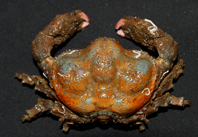Abstract
The Pseudogramma polyacantha species complex was found to harbor cryptic taxonomic diversity with three similar, but genetically divergent, species previously hidden in the complex. The true Pseudogramma polyacantha occurs from French Polynesia to South Africa and has modally 19 (many with 20) segmented dorsal-fin rays, modally 16 segmented anal-fin rays, a relatively short lateral line, no dermal flap or small tentacle dorsally on eye, and extensive scalation on the interorbital, suborbital and dentary. Pseudogramma brederi (previously synonymized with P. polyacantha) is recognized as a valid species occurring from Hawaii to Mauritius and having modally 21 segmented dorsal-fin rays, modally 17 segmented anal-fin rays, a relatively long lateral line, no dermal flap or small tentacle dorsally on eye, and relatively well-developed scalation on the interorbital, suborbital and dentary. Pseudogramma galzini n. sp. is described as a new species known only from French Polynesia and having modally 22 segmented dorsal-fin rays, modally 17 segmented anal-fin rays, a relatively long lateral line, no dermal flap or small tentacle dorsally on eye, and limited scalation on the interorbital, suborbital and dentary. Pseudogramma paucilepis n. sp. is described as a new species known only from French Polynesia and having 20 segmented dorsal-fin rays, modally 16 segmented anal-fin rays, a relatively long lateral line, no dermal flap or small tentacle dorsally on eye, and relatively reduced scalation on the interorbital, suborbital and dentary. A mtDNA COI analysis including all available Pseudogramma sequences shows well-supported genetic divergence between the two new species and among congeners.
References
Baldwin, C.C. & Johnson, G.D. (1993) Phylogeny of the Epinephelinae (Teleostei: Serranidae). Bulletin of Marine Science, 52 (1), 240–283.
Bleeker, P. (1856) Zevende bijdrage tot de kennis der ichthyologische fauna van Ternate. Natuurkundig Tijdschrift voor Nederlandsch Indië, 10, 357–386.
Chakrabarty, P., Warren, M., Page, L.M. & Baldwin, C.C. (2013) GenSeq: An updated nomenclature and ranking for genetic sequences from type and non-type sources. ZooKeys, 346, 29–41.
http://dx.doi.org/10.3897/zookeys.346.5753Delrieu-Trottin, E., Williams, J.T., Bacchet, P., Kulbicki, M., Mourier, J., Galzin, R., Lison de Loma, T., Mou-Tham, G., Siu, G. & Planes, S. (2015) Shore fishes of the Marquesas Islands, an updated checklist with new records and new percentage of endemic species. Check List 11(5) Article 1758: 1–13.
http://dx.doi: http://dx.doi.org/10.15560/11.5.1758Delrieu-Trottin, E., Williams, J.T., & Planes, S. (2014) Macropharyngodon pakoko, a new species of wrasse (Teleostei: Labridae) endemic to the Marquesas Islands, French Polynesia. Zootaxa, 3857 (3), 433–443.
http://dx.doi.org/10.11646/zootaxa.3857.3.6Drummond, A., Ashton, B., Cheung, M., Cooper, A., Duran, C., Field, M., Heled, J., Kearse, M., Markowitz, S., Moir, R., Stones-Havas, S., Sturrock, S., Thierer, T. & Wilson, A. (2009) Geneious v4.6. Available from: http://www.geneious.com/ (accessed 12 December 2015)
Felsenstein, J. (1985) Confidence limits on phylogenies: an approach using the bootstrap. Evolution, 39, 783–791.
http://dx.doi.org/10.2307/2408678Fowler, H.W. & Silvester, C.F. (1922) A collection of fishes from Samoa. Carnegie Institution of Washington Publications, 18 (312), 109–126.
Guindon, S. & Gascuel, O. (2003) A simple, fast, and accurate algorithm to estimate large phylogenies by maximum likelihood. Systematic Biology, 52, 696–704.
http://dx.doi.org/10.1080/10635150390235520Hubert, N., Meyer, C.P., Bruggemann, H.J., Guérin, F., Komeno, R.J.L., Espiau, B., Causse, R., Williams, J.T. & Planes, S. (2012) Cryptic Diversity in Indo-Pacific Coral-Reef Fishes Revealed by DNA-Barcoding Provides New Support to the Centre-of-Overlap Hypothesis. PLoS ONE, 7 (3), 1–8.
http://dx.doi.org/10.1371/journal.pone.0028987Longley, W.H. & Hildebrand, S.F. (1940) New genera and species of fishes from Tortugas, Florida. Papers Tortugas Laboratory, Carnegie Institution of Washington, 32, 223–285.
Posada, D. (2008) jModelTest: Phylogenetic Model Averaging. Molecular Biology and Evolution, 25, 1253–1256.
http://dx.doi.org/10.1093/molbev/msn083Randall, J.E., & Baldwin, C.C. (1997) Revision of the serranid fishes of the subtribe Pseudogrammina, with descriptions of five new species. Indo-Pacific Fishes, No. 26, 1–56.
Randall, J.E., Baldwin, C.C. & Williams, J.T. (2002) Pseudogramma xanthum, a new replacement name for a serranid fish from the subtropical South Pacific Ocean with description of the species. Zootaxa, 40, 1–8.
Schultz, L.P. (1966) Pseudorhegma diagramma, a new genus and species of grammistid fish, with a key to genera of the family and to the species of the subfamily Pseudogramminae. Ichthyologica, the Aquarium Journal, 37 (No. 4), 185–194.
Tamura, K., Peterson, D., Peterson, N., Stecher, G., Nei, M. & Kumar, S. (2011) MEGA5: Molecular Evolutionary Genetics Analysis using Maximum Likelihood, Evolutionary Distance, and Maximum Parsimony Methods. Molecular Biology and Evolution, 28, 2731–2739.
http://dx.doi.org/10.1093/molbev/msr121Tornabene, L., Ahmadia, G.N. & Williams, J.T. (2013) Four new species of dwarfgobies (Teleostei: Gobiidae: Eviota) from the Austral, Gambier, Marquesas and Society Archipelagos, French Polynesia. Systematics and Biodiversity, 2013, 1–18.
http://dx.doi.org/10.1080/14772000.2013.819822Williams, J.T., Delrieu-Trottin, E. & Planes, S. (2012) A new species of Indo-Pacific fish, Canthigaster criobe, with comments on other Canthigaster (Tetraodontiformes: Tetraodontidae) at the Gambier Archipelago. Zootaxa, 3523, 80–88.
Williams, J.T., Delrieu-Trottin, E. & Planes, S. (2013) Two new fish species of the subfamily Anthiinae (Perciformes, Serranidae) from the Marquesas. Zootaxa, 3647 (1), 167–180.
http://dx.doi.org/10.11646/zootaxa.3647.1.8Williams, J.T. & Howe, J.C. (2003) Seven New Species of the Triplefin Fish Genus Helcogramma (Tripterygiidae) from the Indo-Pacific. Aqua, Journal of Ichthyology and Aquatic Biology, 7 (No.4), 151–176.

